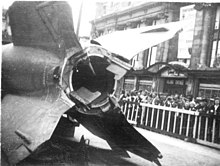von Braun Interceptor
This article needs additional citations for verification. (January 2023) |
| von Braun Interceptor | |
|---|---|
| Role | Interceptor |
| Designer | Wernher von Braun |
| Status | Proposal abandoned |
| Primary user | Luftwaffe (intended) |
| Number built | 0 |
| Developed into | Fieseler Fi 166 Bachem Ba 349 Natter |
The von Braun Interceptor was a VTOL rocket-powered interceptor designed by Wernher von Braun. This aircraft would have used the technology Von Braun had developed for the V-2 rocket during World War II. Von Braun put forward the proposal to Reichsluftfahrtministerium, on July 6, 1939, but project was ultimately not built.[1]
Background
In 1936, von Braun worked to convert some propeller aircraft to be powered by more powerful rocket engines. In 1937, the He 112 V3 and He 112 V5 were fitted with rocket engines, but the V3 was destroyed when it suffered an engine explosion during a test.[citation needed] The He 112 V5, piloted by test pilot Erich Warsitz, was flown to 800 meters (2,625 feet), where Warsitz fired the rocket motor. The He 112 V5 was the first aircraft to be powered by a liquid-fueled rocket engine, paving the way for more rocket-powered planes built by Germany during World War II.[citation needed]
Design

The von Braun Interceptor featured a conventional design with straight, tapered wings. Two fuel tanks, one with alcohol and the other with liquid-oxygen, where located behind the pilot, while the rocket engine was located in the tail. The aircraft was to have an armored,
The von Braun Interceptor plans were given to the Fieseler Company, which developed it into the Fi 166 in 1941. The von Braun Interceptor also inspired the Bachem Ba 349 Natter.[3][4][5]
See also

- List of German aircraft projects, 1939–45
- Messerschmitt Me 163 Komet
- Arado E.381 Kleinstjäger
- Blohm & Voss P 214
- Focke-Wulf Volksjäger 2
- Heinkel P.1077 Julia
- Junkers EF 127 Walli
- Messerschmitt P.1103
- Sombold So 344
- Zeppelin Fliegende Panzerfaust
- Zeppelin Rammer
References
- ^ Aircraft of the Luftwaffe, 1935-1945: An Illustrated Guide, Aircraft of the Luftwaffe, 1935–1945, by Jean-Denis G.G. Lepage, page 216, 250
- ^ World War 2 In Review No. 7: Warplanes, Merriam Press, 2017
- ^ Bachem, Erich. "Zur 'Natter'-Frage!" (in German). Bachem-Werk. Waldsee-Württemberg, December 1944.
- ^ "WW2 German Secret Weapons Episode 15: Von Braun Interceptor". August 16, 2014.
- ISBN 0-85177-836-4.
